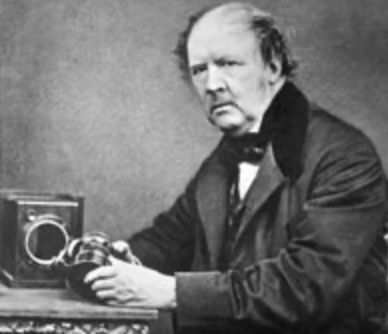FYE 101: Who Came First: Louis-Jacques Mandé Daguerre or William Henry Fox Talbot?
- Sara Lewter

- Oct 9, 2018
- 3 min read
Updated: Feb 9, 2021
The first photograph in history was made in 1826 by Nicephore Niepce; however, his
photo was of poor quality and took about eight hours of exposure time. Niepce sought to improve his process; therefore, after learning of Daguerre’s efforts to obtain permanent pictures , the two became partners. Their partnership lasted from 1829 to 1833 when Niepce died. By the time of Niepce’s death, the two had not come up with a process to make a permanent image. Despite the death of his partner, Daguerre continued experimenting and progressing until 1833 when he finally created a product that was ready to be shown to others. Daguerre discovered that by exposing an iodized silver plate in a camera, it would result in a lasting image. Daguerre’s process, called the daguerreotype process, lasted only twenty to thirty minutes compared to Niepce’s eight hours. Each daguerreotype was remarkably detailed and one-of-a-kind photographic image on a silver-plated sheet of copper. The daguerreotypes were sensitized with iodine vapor, developed in mercury fumes, and stabilized with salt water. In January of 1839, a full description of his daguerreotype was announced at a meeting of the French Academy of Sciences by Francois Arago. Daguerre and the heir of Niepce were then paid in return for the rights to the photographic process. Despite being announced to the French Academy of Sciences in January of 1839, it was not until August that the daguerreotype was explained step-by-step. Despite the process only appearing 1839, Daguerre had searched since the mid-1820s for a way to capture the images he saw in his camera obscura before he finally created the daguerreotype.
Daguerre was not the only one seeking a way to capture a permanent image during this time. William Henry Fox Talbot became frustrated with his camera lucida and camera obscura which led to the jotting down of his thoughts on experiments he could conduct. Talbot wanted to use light on materials to bring forth a picture. In January of 1834, Talbot began experimenting with his ideas. He soon figured out that by coating a sheet of writing paper with salt and brushing it with a solution of silver nitrate, the paper would darken in the sun, and if coated it
again, it would impeded further fading of the image. This discovery would be known as the art of photogenic drawing. Despite his success, he discontinued his experiments and became preoccupied with other activities until hearing about Daguerre. Talbot, worried of losing his claim to fame, began quickly looking for a way to produce permanent pictures that would be superior to Daguerre’s. In January of 1839, Talbot presented his ideas to the Royal Society. He then continued his experiments leading to his discovery that an exposure of mere seconds left an image that could be brought out with the application of a solution composed of gallic acids. Talbot’s discovery, patented in February of 1841, was called the calotype process.
While both Daguerre and Talbot had incredible processes, the daguerreotype had two advantages over Talbot’s paper process. The daguerreotype was crystal clear, but Talbot’s paper images were not sharply defined. Also, Daguerre’s process was freely available to the public while Talbot patented his invention and charged fees for its use. The daguerreotype was the dominant form of photography from 1839 to 1855. On the other hand, while Daguerre’s process had it advantages, it also had limitations. The daguerreotype could only create one-of-a-kind images while Talbots process exposed an image on paper that allowed for multiple positive images to be printed. Daguerre’s process was considered to be superior for the first fifteen years, but Talbot’s process was the one that became the basis of photography today.
Overall, it is clear that the first photograph was created by Niepce and later improved by Daguerre. Despite both processes appearing at the same time, Daguerre had been working on his from the mid-1820s and presented it in January of 1839; however, Talbot did not begin working on his process until 1834 before presenting it in January of 1839. Despite Daguerre’s process not being revealed to the public until August of 1839, it had been revealed to the French Academy of Sciences in January of 1839 where he and the heir of Niepce were compensated for their invention. Despite the fact that I believe Daguerre and Niepce came first, both the daguerreotype and the calotype were great milestones in photography, and they both shaped the way we use photography today.
Works Cited
Metmuseum.org, www.metmuseum.org/toah/hd/dagu/hd_dagu.htm.
Metmuseum.org, www.metmuseum.org/toah/hd/tlbt/hd_tlbt.htm.
Britannica, The Editors of Encyclopaedia. “Louis Daguerre.” Encyclopædia Britannica, Encyclopædia Britannica, Inc., 6 July 2018, www.britannica.com/biography
/Louis-Daguerre.
“Daguerre And Talbot.” Dawn's Early Light, rmc.library.cornell.edu/
DawnsEarlyLight/exhibition/daguerretalbot/index.html.





Comments